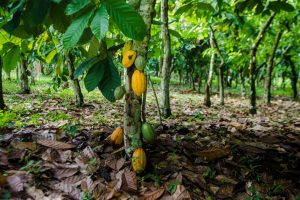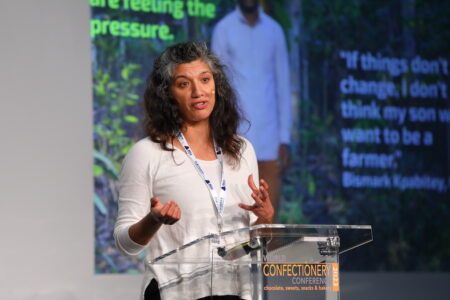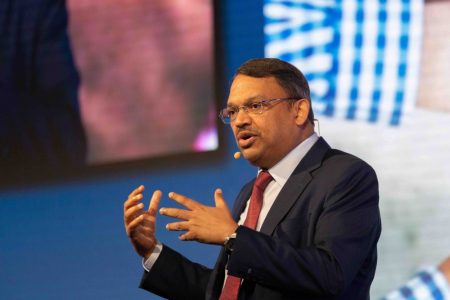Ferrero expands with Chicago innovation hub, amid key sustainability progress

A major new innovation centre for Ferrero’s US operations in Chicago will enable the company’s development of an expanded range of confectionery and sweet packaged goods, writes Neill Barston.
According to the firm, which has just released its latest annual sustainability report covering the period of 2021, its enhanced 45,000 square foot site at the Marshall Field and Company Building, will offer significant potential, as it continually expands its American presence.
Ferrero North America has embarked on a series of major enhancements to it operations over the past two years, including significant increase in distribution facilities, as well as delivering a number of key new product ranges including a new release for its Ferrero Rocher bar series.
As for its latest innovation capabilities, the new facility is set to bring together its bring together its R&D teams throughout the U.S. and also house employees from the firm’s Old Post Office location representing Fannie May, Nutella Café, Keebler, Famous Amos, Mother’s, and other distinctive cookie brands in the group’s portfolio.
“Our goal for this space is to reflect Ferrero’s unique heritage and provide an opportunity to create greater synergies among our teams. This new space will foster the collaboration, creativity and culture that Ferrero is known for around the world,” said Todd Siwak, President, and Chief Business Officer of Ferrero North America.
“I am proud of our growing footprint in Illinois and strongly believe that this innovation centre will propel our teams forward to become leaders in the sweet packaged foods category.”
The new innovation centre, R&D lab, and offices, located on the eighth and ninth floors at 24 East Washington, will bring about 170 cross-functional team members to Chicago’s Loop neighbourhood.
“We are thrilled to join Ferrero as it announces that Chicago will be home to the company’s first innovation centre in the United States,” said Chicago Mayor Lori E. Lightfoot. “Chicago is a global destination for innovation and Ferrero will be well-placed here, benefitting from the city’s connectivity to the world and its strong network of companies driven by tech and innovation. I congratulate Ferrero on this move and welcome them to Chicago as I look forward to more companies realising Chicago’s incredible potential.”
As the company noted, its latest development follows shortly after a major project has begun building a chocolate processing facility and a new plant to make Kinder Bueno products in Bloomington, Illinois and is expanding capacity in its Brantford, Ontario plant. This will link with its new distribution centres in Pennsylvania, Georgia, and Arizona and expanded its North American headquarters in Parsippany, New Jersey.
The move will take place over two phases, with all current Ferrero Chicago employees moving to a temporary office space while construction is completed on the final space. The final office at the Marshall Field & Co. building is set be complete by Spring of 2023.
2021 sustainability report
Development of its innovation facilities comes as the business releases its 13 sustainability report, with the company having previously won plaudits from major global organisations including the WWF for its environmental responsibility policies.
The latest edition of its studies comes amid notable progress for the business, which closed the financial year with a consolidated turnover of €12.7 billion, representing a 3.4% year-on-year improvement.
It now operates a total of 107 companies around the world, including 32 manufacturing plants, with a growing workforce, distributing across more than 170 countries.
As the company revealed in its sustainability report, its goals are broken down into several core areas including: Climate action: reducing carbon footprint by reducing greenhouse gas (GHG) emissions across its operations and value chain and improve energy efficiency.
Another core area is that of water management: responsible water use in its production processes, reducing water consumption and managing wastewater discharge.
Industrial and food waste forms another segment of focus: promoting the transition to a circular economy, where packaging and residuals from manufacturing plants have a value and never become sources of pollution.
Furthermore, the business has also paid notable attention to improving its packaging design, supporting the transition to a circular economy, where packaging never becomes waste.
Ingredient sourcing
In terms of its sustainability with regards to ingredients sourcing, the company confirmed that ‘responsible sourcing is the way we do business and the way we build our supply chains across
all our categories – it is a non-negotiable requirement.’
As the company explained, this requires strong due diligence and supplier-management practices,
traceability and transparency throughout the supply chain, certification and standards, partnerships and collaboration, these last two being deeply rooted in its business culture.
Moreover, the business said it takes a Four Steps approach – the higher the risk, the stronger its level of understanding and protection of the supply chain needs to be.
Transparency is particularly important, with the company’s palm oil and cocoa being mostly traceable back to the plantation or farmer.

In addition, most of the categories that it is engaged with, including raw and packaging materials, follow strict sustainability standards. For example, RSPO for palm oil, independently managed standards like
Rainforest Alliance, Fairtrade for cocoa, FSC and PEFC for virgin paper, or Bonsucro for cane sugar.
Further measures have been taken through partnerships with Save the Children in Ivory Coast and Ghana, ILO in Turkey, and Earthworm in South-East Asia, in a bid to further drive impact.
Packaging matters
On the packaging front, the company said that it continued to follow developments in recycling sorting infrastructure and technology, to build in-depth knowledge and hands-on experience about how design can make an impact on packaging sustainability.
Consequently, the business has designed or re-design packaging according to the available design-for-recycling (D4R) guidelines. These are important for selecting materials, and they are continuously evolving as infrastructure evolves and testing takes place.
Furthermore, the business noted that it faces ‘a patchy and complex waste-management environment’ where consumers receive different instructions depending on where they live, so we need to advocate for more-harmonised rules across geographic regions. New Ferrero Rocher box In September 2021, Ferrero Rocher launched new eco-designed polypropylene boxes.
On its other environmental work, to meet its 2030, target, the company said it took an approach of focusing on reducing emissions from its operations. To that end, it confirmed that it is investing in energy-efficient technologies, increasing the production of on-site renewable energy, improving energy
efficiency and aiming to use alternative sustainable fuels to generate energy.
Regarding scope 2 emissions, arising from purchased electricity, the company said that it is continuing to increase the amount of renewable electricity its factories buy through green certification mechanisms
and, where feasible, Power Purchase Agreements (PPAs).
As for Scope 3 emissions, which it has indirect responsibility for across its value chain, including raw materials an, these account for 92% of its total carbon footprint. With these involving numerous stakeholders, this will require considerable re-imagining of products and packaging and engaging with
suppliers in reducing emissions.
Ferrero said in its latest report, that its current focus is on understanding suppliers’ climate commitments and emissions, to establish a baseline for future activities. The main transport projects introduced in fiscal year 2020/21 were related to shipments within the main European countries and the extension of use of biofuels.
Scope 1 emissions remained constant in absolute value compared to the previous year, even considering a 5.9% production growth, while Scope 2 emissions (market based)
significantly decreased thanks to our investment in renewable electricity. Furthermore, its Scope 1, 2 and 3 emissions intensity ratio remained stable (5.11tCO2eq in 2020/21 and 5.09tCO2eq in 2019/20).
Speaking on the latest sustainability report, CEO Giovanni Ferrero, welcomed the progress that had been made to date.
He said: “The year has, of course, been particularly challenging. The pandemic has highlighted the inequalities that exist in the world, and the social and economic impacts have been different from country to country. In addition, there have been well-publicised disruptions to global freight and logistics, as well as raw-material and energy price inflation.
“However, notwithstanding these challenges, Ferrero as a business has demonstrated resilience and
the solid progress of our sustainability plans has not been affected, as you will read. In addition, our
business continues to expand, both through new acquisitions and through organic growth.”



